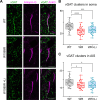This is a preprint.
Lithium Restores Inhibitory Function and Neuronal Excitability through GSK-3β Inhibition in a Bipolar Disorder-Associated Ank3 Variant Mouse Model
- PMID: 37961630
- PMCID: PMC10634991
- DOI: 10.1101/2023.10.26.564203
Lithium Restores Inhibitory Function and Neuronal Excitability through GSK-3β Inhibition in a Bipolar Disorder-Associated Ank3 Variant Mouse Model
Abstract
Bipolar disorder (BD) is a prevalent psychiatric condition characterized by mood dysregulation, psychosocial impairment, and an increased risk of suicide. The gene ANK3 has been identified as a risk locus for BD through multiple genome-wide association studies (GWAS). However, the mechanisms by which ANK3 variants influence BD pathophysiology and treatment response remain unclear. ANK3 encodes ankyrin-G, a protein that organizes the axon initial segment (AIS) and nodes of Ranvier by scaffolding ion channels and cell adhesion molecules to the cytoskeleton. Recent studies show that ankyrin-G interacts with the GABAA receptor-associated protein (GABARAP) to stabilize inhibitory synapses, potentially linking ANK3 variants to inhibitory (GABAergic) signaling deficits associated with BD. We previously demonstrated that the BD-associated variant, ANK3 p.W1989R, disrupts the ankyrin-G/GABARAP interaction, resulting in inhibitory deficits and cortical pyramidal neuron hyperexcitability in mice. In this study, we investigate how lithium, a common BD therapeutic, modulates neuronal excitability in this model. Our findings show that chronic lithium treatment selectively enhances presynaptic GABAergic neurotransmission, reduces neuronal hyperexcitability, and partially rescues AIS length, without altering the density of GABAergic synapses. We also show that the selective glycogen synthase kinase-3 beta (GSK-3β) inhibitor Tideglusib recapitulates the enhancement of presynaptic GABAergic signaling. These findings shed new light on how ANK3 variants may contribute to inhibitory deficits in BD and demonstrate that lithium treatment is able to restore these deficits, likely through GSK-3β inhibition. Furthermore, these findings highlight GSK-3β inhibition as a promising therapeutic strategy for treating BD and other neurological disorders affected by GABAergic dysfunction.
Conflict of interest statement
CONFLICT OF INTEREST The authors have nothing to disclose.
Figures





Similar articles
-
Short-Term Memory Impairment.2024 Jun 8. In: StatPearls [Internet]. Treasure Island (FL): StatPearls Publishing; 2025 Jan–. 2024 Jun 8. In: StatPearls [Internet]. Treasure Island (FL): StatPearls Publishing; 2025 Jan–. PMID: 31424720 Free Books & Documents.
-
The Black Book of Psychotropic Dosing and Monitoring.Psychopharmacol Bull. 2024 Jul 8;54(3):8-59. Psychopharmacol Bull. 2024. PMID: 38993656 Free PMC article. Review.
-
The Lived Experience of Autistic Adults in Employment: A Systematic Search and Synthesis.Autism Adulthood. 2024 Dec 2;6(4):495-509. doi: 10.1089/aut.2022.0114. eCollection 2024 Dec. Autism Adulthood. 2024. PMID: 40018061 Review.
-
Pramipexole in addition to mood stabilisers for treatment-resistant bipolar depression: the PAX-BD randomised double-blind placebo-controlled trial.Health Technol Assess. 2025 May;29(21):1-216. doi: 10.3310/HBFC1953. Health Technol Assess. 2025. PMID: 40455248 Free PMC article. Clinical Trial.
-
Lamotrigine in the maintenance treatment of bipolar disorder.Cochrane Database Syst Rev. 2021 Sep 15;9(9):CD013575. doi: 10.1002/14651858.CD013575.pub2. Cochrane Database Syst Rev. 2021. PMID: 34523118 Free PMC article.
References
-
- American Psychiatric Association, 2013. Diagnostic and Statistical Manual of Mental Disorders, Washington, DC.
-
- Bennett V., Lorenzo D. N., 2013. Spectrin- and ankyrin-based membrane domains and the evolution of vertebrates. Curr Top Membr 72, 1–37. - PubMed
Publication types
Grants and funding
LinkOut - more resources
Full Text Sources
